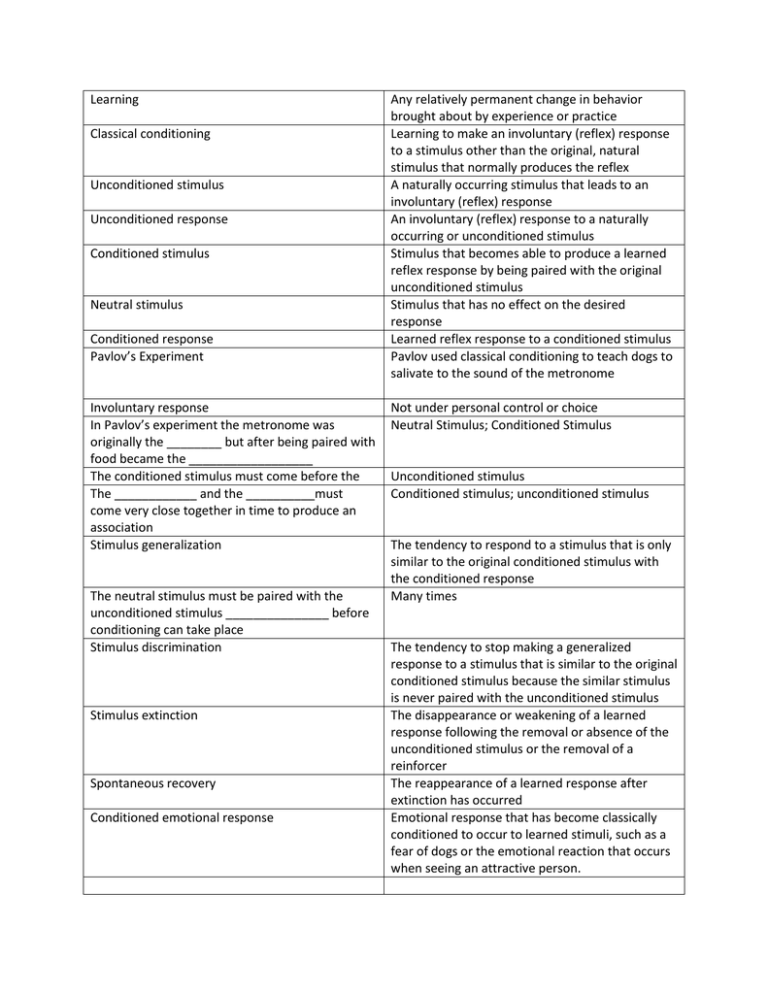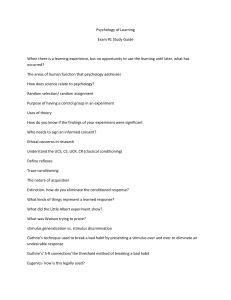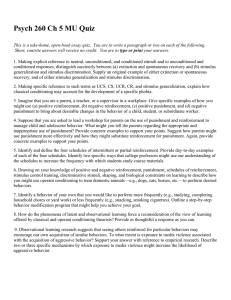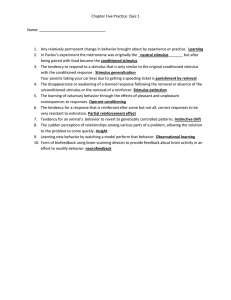Learning Any relatively permanent change in behavior brought
advertisement

Learning Classical conditioning Unconditioned stimulus Unconditioned response Conditioned stimulus Neutral stimulus Conditioned response Pavlov’s Experiment Involuntary response In Pavlov’s experiment the metronome was originally the ________ but after being paired with food became the __________________ The conditioned stimulus must come before the The ____________ and the __________must come very close together in time to produce an association Stimulus generalization The neutral stimulus must be paired with the unconditioned stimulus _______________ before conditioning can take place Stimulus discrimination Stimulus extinction Spontaneous recovery Conditioned emotional response Any relatively permanent change in behavior brought about by experience or practice Learning to make an involuntary (reflex) response to a stimulus other than the original, natural stimulus that normally produces the reflex A naturally occurring stimulus that leads to an involuntary (reflex) response An involuntary (reflex) response to a naturally occurring or unconditioned stimulus Stimulus that becomes able to produce a learned reflex response by being paired with the original unconditioned stimulus Stimulus that has no effect on the desired response Learned reflex response to a conditioned stimulus Pavlov used classical conditioning to teach dogs to salivate to the sound of the metronome Not under personal control or choice Neutral Stimulus; Conditioned Stimulus Unconditioned stimulus Conditioned stimulus; unconditioned stimulus The tendency to respond to a stimulus that is only similar to the original conditioned stimulus with the conditioned response Many times The tendency to stop making a generalized response to a stimulus that is similar to the original conditioned stimulus because the similar stimulus is never paired with the unconditioned stimulus The disappearance or weakening of a learned response following the removal or absence of the unconditioned stimulus or the removal of a reinforcer The reappearance of a learned response after extinction has occurred Emotional response that has become classically conditioned to occur to learned stimuli, such as a fear of dogs or the emotional reaction that occurs when seeing an attractive person. Latent learning Vicarious conditioning Conditioned taste aversion Biological preparedness Stimulus substitution Cognitive perspective Operant conditioning Law of effect Operant Reinforcement Reinforcers Primary reinforcer Secondary reinforcer Positive reinforcement Negative reinforcement Learning that remains hidden until its application becomes useful Classical conditioning of a reflex response or emotion by watching the reaction of another person Development of nausea or aversive response to a particular taste because that taste was followed by a nausea reaction, occurring after only one association. Referring to the tendency of animals to learn certain associations, such as taste and nausea, with only one or few pairings due to the survival value of learning Original theory in which Pavlov stated that classical conditioning occurred because the conditioned stimulus became a substitute for the unconditioned stimulus by being paired closely together Modern theory in which classical conditioning is seen to occur because the conditioned stimulus provides information or an expectancy about the coming of the unconditioned stimulus The learning of voluntary behavior through the effects of pleasant and unpleasant consequences to responses. Law stating that if an action is followed by a pleasurable consequence, it will tend to be repeated, and if followed by an unpleasant consequence, it will tend not to be repeated. Any behavior that is voluntary Any event or stimulus, that when following a response, increases the probability that the response will occur again. Any events or objects that, when following a response, increase the likelihood of that response occurring again. Any reinforcer that is naturally reinforcing by meeting a basic biological need, such as hunger, thirst, or touch. Any reinforcer that becomes reinforcing after being paired with a primary reinforcer, such as praise, tokens, or gold stars. The reinforcement of a response by the addition or experiencing of a pleasurable stimulus The reinforcement of a response by the removal, escape from, or avoidance of an unpleasant stimulus. Continuous reinforcement Fixed interval schedule of reinforcement Partial reinforcement effect Variable interval schedule of reinforcement Fixed ratio schedule of reinforcement Variable ratio schedule of reinforcement Punishment Punishment by application Punishment by removal Discriminative stimulus Shaping Successive approximations Instinctive drift Behavior modification Token economy Applied behavior analysis (ABA) Biofeedback The reinforcement of each and every correct response. Schedule of reinforcement in which the interval of time that must pass before the reinforcement becomes possible is always the same The tendency for a response that is reinforced after some but not all, correct responses to be very resistant to extinction. Schedule of reinforcement in which the interval of time that must pass before reinforcement becomes possible is different for each trial or event Schedule of reinforcement in which the number of responses required for reinforcement is always the same Schedule of reinforcement in which the number of responses required for reinforcement is different for each trial or event Any event of object that when following a response, makes that response less likely to happen again The punishment of a response by the addition or experiencing of an unpleasant stimulus The punishment of a response by the removal of a pleasurable stimulus Any stimulus such as a stop sign or a doorknob, that provides the organism with a cue for making a certain response in order to obtain reinforcement The reinforcement of simple steps in behavior that lead to a desired more complex behavior Small steps in behavior, one after the other, that lead to a particular goal behavior Tendency for an animal’s behavior to revert to genetically controlled patterns The use of operant conditioning techniques to bring about desired changes in behavior Type of behavior modification in which desired behavior is rewarded with tokens Modern term for a form of functional analysis and behavior modification that uses a variety of behavioral techniques to mold a desired behavior or response. Using feedback about biological conditions to bring involuntary responses, such as blood pressure and relaxation, under voluntary control Neurofeedback Insight Learned helplessness Observational learning Learning/performance distinction Three ways to make punishment more effective Form of biofeedback using brain-scanning devices to provide feedback about brain activity in an effort to modify behavior The sudden perception of relationships among various parts of a problem, allowing the solution to the problem to come quickly The tendency to fail to act to escape from a situation because of a history of repeated failures in the past Learning new behavior by watching a model perform that behavior Referring to the observation that learning can take place without actual performance of the learned behavior 1) Punishment should immediately follow the behavior it is meant to punish 2) Punishment should be consistent 3) Punishment of the wrong behavior should be paired, whenever possible , with reinforcement of the right behavior







